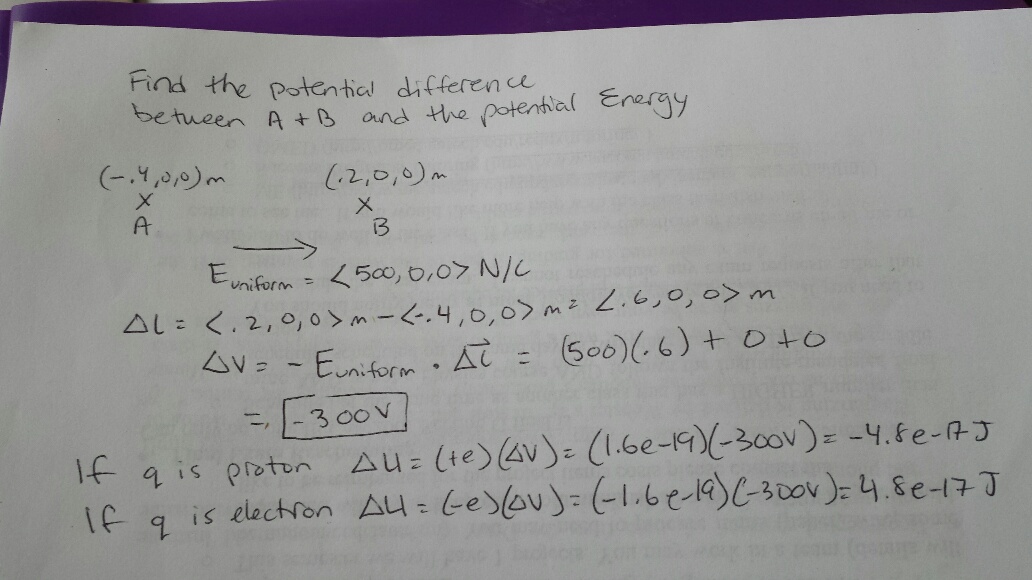Electric Potential: Difference between revisions
Rmohammed7 (talk | contribs) |
Rmohammed7 (talk | contribs) |
||
| Line 52: | Line 52: | ||
A proton is located at the origin. Location C is 1e-10 m away from the proton, and location D is 2e-8 m from the proton, along a straight line radially outward. First, find the potential difference from C to D. Then find how much work would be required to move an electron from location C to D. | A proton is located at the origin. Location C is 1e-10 m away from the proton, and location D is 2e-8 m from the proton, along a straight line radially outward. First, find the potential difference from C to D. Then find how much work would be required to move an electron from location C to D. | ||
[[File:WIKIPAGE. | [[Media:File:WIKIPAGE.ogg]] | ||
===Difficult=== | ===Difficult=== | ||
Revision as of 21:17, 5 November 2015
Electric Potential is the potential energy associated with interacting charged particles that create electric fields and impact each other through these fields. Electric potential is found by travleing across a path through a uniform or nonuniform electric field.
Review of Potential Energy
--editing in progressrmohammed7 (talk) 17:18, 25 October 2015 (EDT) Short Description of Topic
Potential energy can be thought of as the energy that is stored within a system that will soon be utilized for some other action. It is the opposite of kinetic energy, which is the energy associated with something in motion. For studying electric potential of charged particles, we first need to understand that sigle particles themselves dont really have potential energy. When we analyze a system for electric potential, we need to choose a a system containing one or more objects/particle/etc.. The potential energy will be derived from the interactions between the objects within our system. On the other hand, kineic energy will be related to the work done by the surroundings of the system.This value can be changed if the work done is positive or negative. Therefore, the change in kineic energy of our system must be equal to the work done by the surroundings. Work can be derived by calculating the dot product of the force and displacement. Potential energy is asscociated with the internal work of the system, that is, work that is done by objects counted within the system. Therefore, the potential energy change of a system is equal to the negative interior work. Now, to put all this together, we have the conservation of energy rule. This states that energy cannot be created or destroyed between events of interacting objects. That is why delta K plus delta U must be zero.
The Main Idea
When calculating the changes in potential energy of a system, it would be useful to find a quantity that is unique from the charge of out particle. After finding this variable, we can multiply it by the charge to get or delta U. Regardelss of whether our particle is a proton or electron, our change in potential energy formula boils down to (some charge)*(-Ex*deltaX). The part that is the same in both cases is the Ex times deltaX. This is called the difference of electric potential between 2 locations. This value is usually notated as DeltaV, with units of volts.
A Mathematical Model
Finding Potential Differences in Uniform Fields. DeltaV = -Efield (dot product) deltaL Remember that dot product of 2 vetors = (magnitude of vector1)*(magnitude of vector 2)*cos(angle between them)
How to determine the sign of potential difference: If your path that you are considering goes in the same direction as the electric field, the sign will be negative (-) If your path goes in the opposite direction of the electric field, the sign will be positive. (+) If the path is perpendicular to the electric field, it will be zero.
Finding deltaV in nonuniform Fields: DeltaV = -integral from (initial position to final position) of [Efield dot product deltaL]
Some Key Points
- In a conductor we know that the electric field is zero. Therefore, the potential difference is zero as well(since it is constant everywhere).
- The potential difference between 2 locations does not depend on the path taken between the locations.
- Round Trip Potential Difference is always zero, If you start your path from a certain points and end your path at the same point, deltaV will be zero.
- In an insultor, the electric field is (Eapplied/K)m where K is a dielectric constant.Therefore, DeltaV = (deltaV inside vaccum)/K
A Computational Model
Watch this video for a more visual approach [1]
Examples
Be sure to show all steps in your solution and include diagrams whenever possible
Simple
Middling
A proton is located at the origin. Location C is 1e-10 m away from the proton, and location D is 2e-8 m from the proton, along a straight line radially outward. First, find the potential difference from C to D. Then find how much work would be required to move an electron from location C to D.
Difficult
Connectedness
- How is this topic connected to something that you are interested in?
- How is it connected to your major?
- Is there an interesting industrial application?
History
Put this idea in historical context. Give the reader the Who, What, When, Where, and Why.
See also
Are there related topics or categories in this wiki resource for the curious reader to explore? How does this topic fit into that context?
Further reading
Books, Articles or other print media on this topic
External links
Internet resources on this topic
References
This section contains the the references you used while writing this page
